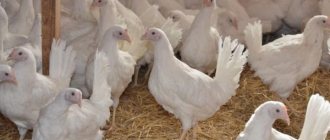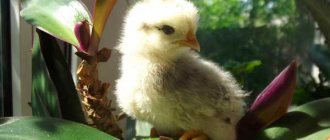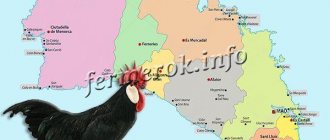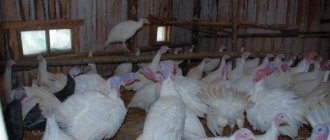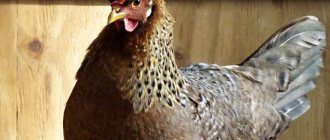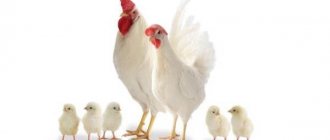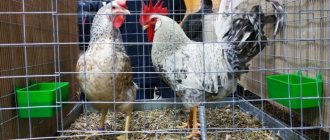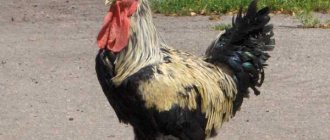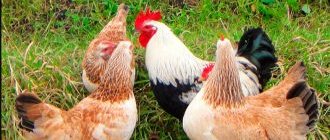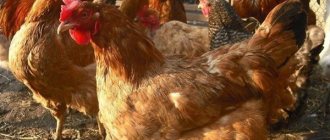The breed of chickens, or more accurately, the Rhodonite cross, was created in Germany thanks to the selection of Lohman Brown and Rhode Island. In 2002, the chicken came to the Russian Federation to a poultry farm in the Sverdlovsk region, located in the village of Kashino, near Yekaterinburg. Russian breeders were faced with the task of improving the breed, making it more adaptive to our climatic conditions.
In today's publication you will find a detailed description of Rhodonite chickens, see photos of chickens and read reviews from those farmers who are familiar with this bird firsthand.
Origin
In 2002, breeders from Sverdlovsk began developing a new breed. They had two goals:
- the bird should be as egg-laying as possible;
- can withstand the harsh Russian winter well.
It took scientists six years to create a new unique laying hen, Rhodonite. It appeared as a result of crossing two strong crosses: the German Lohman Brown and the American Rhode Island.
In 2009, the breed was officially registered in the State Register of the Russian Federation. The level of productivity and unpretentiousness of Rhodonit laying hens was immediately highly appreciated by the owners of poultry farms. Today, poultry provides a significant portion of the food eggs produced in Russia.
Appearance and breed standard
Rhodonite is very similar to its ancestors. An inexperienced poultry farmer will easily confuse them with each other. Among the external characteristics, it is important to pay attention to the following indicators:
- medium sized head;
- the beak is yellow, seemingly edged on top with a wide brown line;
- the rooster has a leaf-shaped red comb of medium size;
- bulging green-orange eyes;
- fluffy high ponytail;
- small wings;
- red well-developed earrings;
- short legs with practically undeveloped muscles.
The peculiarity of the anatomical structure is its light bones and wide back. The bird has dense plumage. Rhodonites have a wide variety of colors: from light brown to gray. There are two lines of the breed: Rhodonite 3 and 2. They are distinguished by high productivity, survival rate above 96% and easy adaptation to different conditions.
It is worth noting that deviations from the standard in appearance do not affect egg production. Due to the fact that the bird was bred recently, individuals with defects in plumage are quite common.
Video
We invite you to watch several videos filmed by experienced poultry farmers who work with Rodonite chickens and share tips from their own practice:
About the author:
Found a mistake? Select the text with the mouse and click:
Ctrl + Enter
Do you know that:
A new product from American developers is the Tertill robot, which weeds weeds in the garden. The device was invented under the leadership of John Downes (creator of the robot vacuum cleaner) and works autonomously in all weather conditions, moving over uneven surfaces on wheels. At the same time, it cuts off all plants below 3 cm with the built-in trimmer.
Productivity
From 16 weeks, Rhodonit hens begin to lay eggs. With proper care, one hen produces about 300 eggs per year. The average weight of one egg is 65 grams, the shell color is brown.
A decline in egg production occurs at the age of 1.5 years. In order to extend the productive period, laying hens are given a “rejuvenating vaccine” (SSY-76). The problem is the high cost of the medicine - not every farmer is ready to buy it. An alternative method is to add a yeast supplement to the diet, which extends the egg production period by about a year. Many poultry farmers do not use either the first or second method, but simply update the productive flock.
The weight of birds for laying hens is significant. Birds that are culled are used for meat, but its taste is below average - it is tough and can only be used for cooking or industrial processing.
Productive qualities
The maximum weight of an adult rooster reaches 3 kg, chickens gain weight of 2 kg. The egg-laying period for laying hens begins at four months of age. In one season, you can get approximately three hundred eggs from a chicken. Representatives of the breed reach their highest level of productivity at 1.5 – 2 years. After this, a rapid decrease in the number of eggs is observed.
One of the ways to temporarily restore indicators is the introduction of a rejuvenating vaccine, thanks to which egg-laying activity is maintained for at least another 80 weeks. The product itself is small in size, weighing 60 grams.
Selective selection has made hens incapable of hatching offspring, and therefore laying hens are not used in breeding. However, the breed has another advantage - a large number of eggs, which makes the birds very valuable for keeping on farms.
READ Cat breeds with short legs - names, descriptions and photos
Hatching instinct
The breed has virtually no maternal instinct. For this reason, Rhodonites are not bred. Laying hens do not hatch eggs or care for chicks. In addition, it is not practical to breed offspring from eggs obtained on the farm. Like all artificially bred hybrids, the young animals of this cross do not inherit the key economic parameters of their parents.
You can update your purebred stock only by purchasing hatching eggs and chicks. Due to the fact that in our country Rhodonite 3 is a popular inexpensive rock, this is an excellent option.
Possible pitfalls
What to do if the Rhodonite chickens selected from the photo and praised in reviews and descriptions do not want to lay eggs? Find out the reasons for this behavior.
First of all, you should not buy these birds based on photos. Phenotypically, Rhodonit-3 is indistinguishable from other egg-laying crosses. But other crosses reduce productivity much earlier than Rhodonite, and the seller can sell yearling Loman Brown or other similar chickens under the guise of Rhodonite. There will be no sense in such overstuffing. You should try to take a bird where its age is clearly visible. It’s better to let her be a “freeloader” for a month, but then reward the owner with eggs, than to turn out to be a complete “dummy.”
An unbalanced diet is also one of the reasons for decreased egg production. With a lack of vitamins and minerals, chickens not only lay fewer eggs, but may eat or “shed” them.
A third reason could be obesity or malnutrition. In both cases, the hen stops laying eggs.
Molting occurs in chickens when the egg-laying season ends. During molting, chickens, if they lay eggs, do so very rarely. And often they stop laying eggs completely.
And the worst thing is parasites and infectious diseases. The latter may lead to the need to slaughter the entire livestock.
Andrey Korolenkov, town. Vishnevogorsk
What is boring about all industrial crosses is that they are as similar as two peas in a pod. If it is a broiler, then it is white, if it is a layer, then it is either red or white. So I took Rhodonites only with the guarantee that these were really Rhodonites, and not some other cross. I took grown two-month-old chickens. They started laying eggs at 4 months. I've now had them for three years. So far egg production has not been reduced, but I have already been told that they will have to be replaced on the fourth.
Dmitry Pogorelov, p. Zarechnoye
For eggs I keep our Russian Rhodonite-3
I really like their frost resistance, which is very important in our area. These chickens have to be fed more than outbred laying hens
So the return is much higher. Where does a chicken get “building materials” for an egg, if not from food? So we feed the chickens well, and they delight us with eggs for several years. I really like their long-term productivity because I don’t have to buy new chickens every year.
This is interesting: Jersey giant chicken breed and chickens of this breed: we are considering the issue
Content specifics
Rhodonit chickens are unpretentious and easy to care for, but in order for the laying hen to maintain good productivity and not get sick, you need to follow simple rules.
Suitable region and climate
Rhodonit hens maintain high egg production in the most unfavorable climatic conditions. Initially, the cross was designed for industrial cultivation, but soon the breed was appreciated by private farmers. Today the bird can be found in almost all regions of Russia.
What is valuable is that Rhodonite thrives in areas with cold and long winters. But the breed does not tolerate heat well, the bird begins to lose weight and stops laying eggs.
How to maintain and care
Rhodonite is not capricious and tolerates frosty winters well. Birds can live both in a chicken coop and in a barn - the main thing is to properly arrange perches and nests for laying hens.
One of the important maintenance conditions is the presence of supply and exhaust ventilation in the poultry house. It’s easy to make, just install a window. It is also permissible to make a hole in the wall and be sure to cover it with mesh so that rodents cannot enter the room.
Chicken coop parameters:
- room height up to 2 m;
- temperature from -2°C to +28°C;
- there should be no drafts in the room;
- 20 individuals are kept in at least 10 sq.m.
It is better to make the window on the south side, and the door on the east. The height of the perches is no more than 1 m. Wooden boxes filled with hay or straw are adapted for nests. Make sure there is a “bathtub” made of ash and sand in the corner of the chicken coop. With its help, birds get rid of skin parasites.
Place feeders along the walls on the floor - place dry and wet food in different containers. Place a layer of sawdust or straw on the floor. Change it once a week.
Also, do not forget to regularly ventilate the chicken coop. Once a year, the room should be whitewashed with lime to avoid the appearance of parasites. In the summer, while the birds are on the run, treat the empty poultry house with special antiseptic sprays.
Feeding
The food used is a mash of grated vegetables, fruits, chalk greens with the addition of fish or meat broth, as well as special mixtures.
Dry food is made from wheat. To improve productivity, add special mineral supplements to your diet. To maintain the required level of calcium in the body, give your chickens eggshells.
For good digestion, small stones or gravel are mixed into the food of laying hens. Birds should always have clean, fresh water. It must be changed every day. It is worth noting that the feed costs of Rhodonit are higher than other known egg breeds.
Walk
For normal functioning, chickens must walk every day. Since Rhodonites are very active, the walking yard should be large with high fences. Crosses can be released outside down to -25C. In summer, the herd can spend the whole day walking. To prevent precipitation or hot sun from depriving birds of a walk, it is recommended to make a canopy over the walking area.
Reviews
According to farmers, rhodonite has a number of advantages:
- Early and high egg production.
- Frost resistance - laying hens can withstand frosts down to -20 ° C and continue to lay eggs at sub-zero temperatures. To maintain good productivity in winter, the temperature in the chicken coop should be maintained above -2 °C. When the temperature rises above +28 °C, egg production also decreases.
- High vitality. The hatchability of chickens is 87%, the survival rate of young animals up to 17 weeks is 99%, the survival rate of 17-80 week old females is 97%.
- Quick adaptation to new conditions.
- Birds are easy to care for.
The main disadvantage of rhodonite is the lack of a “brooding instinct,” which entails the loss of eggs. Chickens can lay eggs anywhere if they are free-range.
When breeding, the incubation method is used, but the characteristics of this cross will not be transferred to the chickens, moreover, they will be weak, small and lay little eggs.
Experts also note that one of the disadvantages is the low meat yield.
Raising chickens
Chicks of this breed have an amazingly low mortality rate, so, as a rule, the entire brood reaches adulthood. Raising Rhodonite chickens is not difficult, but you need to take into account a few simple rules:
- Once the chick has hatched, transfer it to the brooder.
- Use an infrared lamp for heating.
- Cover the bottom of the brooder with sawdust.
- Feed the chicks immediately after they are dry.
- Chicks should always have access to a drinking bowl. Change the water three times a day.
- When the chicks are 14 days old, take them out for a walk. The weather should be dry and warm.
Breeding Basics
Instinct and cost
Chickens of the Rhodonite breed are completely devoid of the brooding instinct, so it is recommended to place hatching eggs under another bird or put them in an incubator.
Natural breeding is not suitable for rhodonite crosses. Roosters of this breed can fertilize eggs, which will produce offspring, but its productive qualities will be much lower than the original ones.
Therefore, it is recommended to purchase hatching eggs from certified suppliers, or already hatched young animals. Chickens are selected only from trusted producers. Viable chicks are distinguished by brilliant plumage and actively eat food.
The price for hatching eggs is 10 rubles per piece, the cost of chicks does not exceed 30 rubles per piece. Young laying hens are offered at prices up to 450 rubles. Wholesale purchase will cost twice as much.
Incubation
Leveled eggs that have been stored for no longer than 10 days are suitable for incubation. They need to warm up before being placed in the incubator, so they are left in the room for several hours.
Set the incubator temperature to + 37.9 degrees. In 2-3 days it is reduced to + 37 degrees. Mass hatching of Rhodonite chicks begins on the 21st day.
Raising chickens
Feeding young animals does not differ from the rules for feeding other breeds. A balanced diet allows you to completely preserve the brood of rhodonite babies.
The hatched chick needs warmth, so it is carefully transplanted into a cardboard box lined with soft rags. Heating is carried out with an infrared lamp and bottles of warm water.
The first food is given after the fluff of the young animals has dried. It is advisable to finely chop the boiled egg. Millet or crushed wheat is also poured.
Millet is allowed to be left in the feeder, and a half-eaten egg is removed after 20 minutes. On the third day, add chopped herbs and low-fat cottage cheese.
Rhodonite chickens are recommended to be fed with special feed for chickens containing a vitamin and mineral complex. By 6 weeks, young animals are fed similarly to adult animals.
Determination of gender
Rhodonit 3 chickens are distinguished by gender on the second day after birth.
Chickens are characterized by brown down color, which becomes lighter on the back. Light rims are visible around the eyes.
Cockerels are distinguished by light down, with a dark spot visible on the head. The rims around the eyes are dark in color.
Advantages and disadvantages
Owners leave a lot of positive feedback on Rhodonite laying hens. This breed is a win-win option for poultry farmers whose priority is obtaining eggs.
Among the advantages are:
- high egg production;
- cold resistance;
- peaceful disposition;
- good immunity;
- loyal price.
The breed has no obvious disadvantages. The breeder will be dissatisfied with Rhodonites only if he has not familiarized himself with the characteristics of the breed in advance. It is worth considering that this is an egg type of bird, so the meat yield will be low. Also, some are unhappy with the increased activity of chickens and the need to walk them.
Walking space
Another feature of rhodonites is that they cannot be kept in cages; chickens need regular walks. To lead an active life, the birds are provided with a fenced area next to the poultry house. The height of the fence should not be less than one and a half meters, which is associated with the ability of chickens to fly.
Chicken breeding rhodonite
The breed was bred to withstand harsh climatic conditions. They are able to adapt to both cold and heat. In theory, rhodonites can continue to lay eggs even at -20 degrees, however, not a single laying hen will live long in such conditions, which will be associated with severe depletion of the body. The owner may face the same danger if he does not equip the premises with a ventilation system for the summer and does not make canopies on the street. The temperature in the chicken coop during the heat should not reach +28 degrees or more.
Typical diseases and their prevention
The breed has good immunity. With proper maintenance and care, birds practically do not get sick.
Inspect all flocks weekly for ticks and other parasites. If you find traces of them, treat the birds with special insecticides.
When an adult bird becomes ill, it must be isolated and the cause of its poor health determined. Among the most common diseases of Rhodonites are:
- Gastroenteritis, which can occur due to low-quality or missing feed.
- Pullorosis, accompanied by lethargy, drooping wings, refusal to eat, and rapid breathing. The disease often leads to death.
- Mycoplasmosis, the symptoms of which are swelling under the eyes, screaming.
- Tuberculosis, obvious signs of which are sudden weight loss, pallor of the comb and wrinkled earrings.
- If Rhodonite suffers from frequent diarrhea, mixed with mucus and blood, then most likely it is coccidiosis.
- With bronchitis, birds stop laying eggs, breathe with difficulty and cough.
We talked in more detail about what causes laying hens to die here.
Where to buy and what prices
The cost of Rhodonite is pleasantly pleasing:
- a day-old chick costs 30 rubles;
- young animals – 350 rub.
You should not buy birds from private owners based on photos, because they can sell you any other cross that looks like Rhodonite. It is better to purchase chickens from large farms that specialize in breeding this breed.
Among the analogues are:
- Highsex White laying hens, which have increased egg production - about 408 eggs per year. Birds are unpretentious and friendly. We told you more about Hisex White laying hens here.
- Borkovskaya Barvistaya. The bird is distinguished by its resistance to frost, calm disposition and good maternal qualities. True, the breed is inferior in egg production to the previous ones - an average of 260 eggs per year. We told you more about Borkovskaya Barvistaya chickens here.
conclusions
- Rhodonite is a young rock that can withstand long and cold winters. Egg production is preserved.
- The bird is active, so it needs a spacious walking yard with greenery.
- A laying hen produces about 300 eggs per year.
- Rhodonite is an egg breed; chicken meat is tough and not tasty.
- The bird has no brooding instinct.
- Chicks do not inherit traits of productivity from their parents, so it makes no sense to breed birds on your own from individuals available in the backyard.
- Keep the coop clean to keep the birds healthy.
- Do not buy laying hens of the Rhodonit breed from private sellers. Give preference to specialized large farms.
Features of feeding
Birds of this breed, as well as other egg-laying chickens, need adequate nutrition. The diet should consist mainly of fresh greens (dried nettles in winter), vegetables, grains, chalk, crushed eggshells, etc. It is also recommended to feed special feed.
By the way, in the case of mixed feed, it is better to add PC-2 to chicks aged from 1 to 8 weeks, and then you can switch to PC-4.
Starter for chickens pk-2
Compound feed PC – 4
Proper arrangement of a poultry house for chickens of the Rhodonite breed
What about mineral supplements?
The diet of laying hens must necessarily include minerals that take part in the formation of eggshells. If there is a deficiency of these substances, the egg shells may be too thin or absent altogether.
Chickens need to be given calcium, the sources of which can be:
- crushed shells;
- chalk;
- ground limestone.
And in order to improve the digestive functions of laying hens, they can additionally be given fine-grained insoluble minerals (such as gravel, for example).
